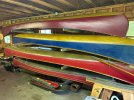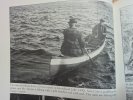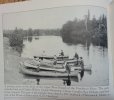AldenWitham22
Curious about Wooden Canoes
Hey all, as someone who works in wood finishing (historic preservation in particular) the topic of shellac comes up often in my life. More than any sane or normal person. As someone who likes to use ands restore old canoes the topic of shellac below the waterline is a natural extension on that. As someone who works in wood finishing professionally, who is under 60yo, something as controversial as using shellac on the bottom of a boat gets me laughed at. I've had the old guys tell me I'm just wrong or that the sources I reference are wrong and that they mean something else when they say "shellac". My own experiences are glossed over, even when I show a boat that was in the water with no issues.
Give me some ammunition here history buffs, please! I would think that my own first-hand use would be enough, considering it's something that I have more experience with than the guys I have this debate with, but apparently not. Can you give me some good first hand accounts of this to knock the compression socks off those boomers?
Give me some ammunition here history buffs, please! I would think that my own first-hand use would be enough, considering it's something that I have more experience with than the guys I have this debate with, but apparently not. Can you give me some good first hand accounts of this to knock the compression socks off those boomers?




